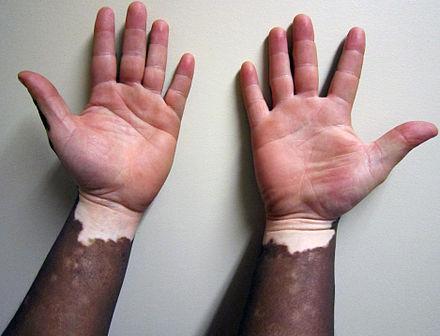How does vitiligo develop?

Vitiligo is an acquired, limited skin pigment loss patch. Any ageIt can occur in all people, but it is more common in young adults and can occur anywhere in the body.However, they are mostly seen on exposed areas such as the face, neck, wrists, chest and back. The number of patches may be large or small, withIn some cases, only a small white spot occurs, which remains unchanged for a long time, while in others, it may gradually spread to form a white spot.White spots of different sizes and shapes, with clear boundaries between the white spots and normal skin.Brown coloration. Its disease generally progresses slowly, and most can persist for a long time, with some individualPatients develop rapidly and spread more quickly. Since it is mostly seen on the face and exposed parts of the body, due to theThis affects the cosmetic appearance and often causes annoyance and mental unhappiness to the patient.
The causes of vitiligo are still not well understood. However, it is known that the skinThe disruption and destruction of the production of skin melanin is the main cause of the occurrence of skin white spotsCause. And what factors can influence the production of melanin in the skin? It is generally believed that there are the followingNext points:
1. Genetic factors. According to relevant data, patients with a positive family history of aboutThe percentage is 18.7% to 40%, so there is a clear genetic factor.
2. Decreased autoimmune function. Because some patients are secondary to thyroid disordersdisease, pernicious anemia, Addison's disease, and other autoimmune diseases. ImmunocompromisedVitiligo can occur as a result of the lack of melanocytes and melanin in the basal layer of the epidermis.
3. Neurochemical factors. Because vitiligo often occurs symmetrically. Or present ganglionicsex or in a banded distribution, so it is presumed that due to the release of certain chemicals from peripheral nerve endingsThe chemical factor, which has the effect of inhibiting melanogenesis and destroying melanocytes face onset.
4. Self-destruction of melanocytes. It has been suggested that the widespread use in industry of certainPhenols, through direct contact and inhalation, have a selective destructive effect on melanocytesThe use of the disease has led to an increase in the incidence of the disease.
5. Low levels of actinide ions in the body. This is because melanin is produced from tyrosine via the actinium containingCopper is formed by hydroxylation of copper by tyrosinase followed by oxidation. Therefore, the bodyReduced levels of copper ions can affect melanin formation.
6. Mental factors. Traditional Chinese medicine believes that this disease is mostly due to emotional disorders, liver qi stagnation, qiThe mechanism is not smooth, internal injuries to the seven emotions, compounded by the wind, fighting in the skin, qi and blood run out of order and lead to.As a result, severe mental stimulation or trauma can also predispose to the condition.
In conclusion, vitiligo is formed by a variety of factors that, in particularIt is the mental factors that are important in causing melanocyte destruction or inhibiting melanin formationReason.
Reference: Ma Deshui, Newly edited manual therapy for all diseases, China Youth Publishing House.
As the title suggests, many people with vitiligo want to know what causes this disease, but unfortunately the cause is still unclear. Recent studies have suggested that it is related to the following factors:

The theory of genetics is shared by many, and some studies have suggested that vitiligo may be an autosomal dominantly inherited skin disease. Foreign authors counted 30% of patients with a positive family history and found that both of the monozygotic twins developed the disease. Domestic reports of positive family history are 3% to 12%, which is lower than foreign reports.
The relationship between autoimmunity and the pathogenesis of vitiligo has received increasing attention. Many scholars have noted the high rate of combined autoimmune diseases among patients and their family members, with thyroiditis, hyper- or hypothyroidism, diabetes mellitus, chronic hypoadrenalism, pernicious anemia, rheumatoid arthritis, and malignant melanoma being the common ones. And vitiligo patients in the serum, some people detected a variety of organ-specific antibodies, such as anti-thyroid antibodies, anti-gastric wall cell antibodies, anti-adrenal antibodies, anti-parathyroid antibodies, anti-smooth muscle antibodies, and the detection rate is significantly higher. In addition to autoimmune diseases, the incidence of vitiligo is 10 to 15 times higher than the general population. Recently it has been found that patients with vitiligo have antibodies against the surface antigen of melanocytes, called vitiligo antibodies, the titer of which is related to the degree of skin pigmentation loss in patients, and the titer increases with the expansion of the area of skin lesions, and it has also been found that animals suffering from vitiligo have a similar phenomenon, which proposes that the disease is an autoimmune disease of melanocytes.Behl(1977) found that there are mononuclear cells aggregated at the edge of progressive white spots, invading the dermal epidermal junction and enter the epidermis by the destroyed basement membrane, making the melanocytes and melanin in that area absent, suggesting that the disease may be an autoimmune disease of delayed hypersensitivity reaction. In addition, internal or topical corticosteroids, especially those lesions that are not distributed according to dermal nodes, have better efficacy, which also indirectly proves the immune mechanism of this disease.
Many clinicians have found that mental factors are closely related to the onset of vitiligo, and it is estimated that about 2/3 of patients have mental trauma, excessive tension, depression or frustration at the onset of the disease or during the stage of lesion development. Stress can lead to increased catecholamines, such as adrenaline can directly affect the depigmentation; stress can also increase ACTH secretion, resulting in increased secretion of corticosteroids, while mobilizing sugar and free fatty acids, stimulating insulin secretion. Insulin indirectly stimulates the brain to increase L-tryptophan, so that the brain 5-hydroxytryptamine synthesis increases, and the metabolite of 5-hydroxytryptamine is melatonin, fucoxanthin receptor hyperactivity plays an important role in the pathogenesis of vitiligo. Melatonin receptor hyperactivity can increase the activity of theophyllase, these enzymes inhibit melanin biochemistry, but later make its generation activation, resulting in the accumulation of toxic intermediates of melanin metabolism in melanocytes, so that the melanocyte death, and ultimately lead to vitiligo. Some scholars have observed degenerative changes in the nerve endings at the white spots, and the degree of change seems to be related to the course of the disease, this phenomenon also supports the neurochemical theory.
The basic lesion of vitiligo is the partial or complete loss of function of epidermal melanocytes. 1971 foreign scholars put forward this doctrine. It is believed that vitiligo is due to its epidermal melanocyte hyperfunction, promote the depletion and early decline, and may be due to the accumulation of toxic melanin precursor substances synthesized by the cells themselves. Experiments have proved that certain chemical substances have selective destructive effects on melanocytes, so that the skin decoloration, these substances are mostly substituting for phenolic chemicals decolorants, such as hydroquinone monophenyl ether, hydroquinone, Sydney phenol, hydrogen peroxide, etc., are decolorizing effect on the skin and hair. Vitiligo has increased in recent years, probably related to the development of industry and increased exposure to such chemicals.
Other factors include: trauma including trauma, surgery, scratching, etc. can induce vitiligo. Certain endocrine diseases, such as hyperthyroidism and diabetes, can be accompanied by vitiligo. Sun exposure is prone to vitiligo. The pathogenesis of vitiligo doctrine is more, and all have a certain basis, but all have a certain one-sidedness.
At present, it is believed that the onset of its genetic factors, but also in a variety of internal and external factors, immune function, neurological and endocrine, metabolic function and other aspects of dysfunction, resulting in enzyme system inhibition or melanocyte destruction or melanin formation disorder, resulting in loss of skin pigmentation. I hope it will be helpful to you.
Welcome to pay attention to the "Chinese medical science platform" headlines, to get more professional and original medical science knowledge, this article is original content, unauthorized refused to reproduce.
Vitiligo is a condition in which a type of melanocyte in the skin that is capable of producing melanin is destroyed and does not work well enough to produce melanin normally, resulting in a gradual loss of pigment, causing a disorder of skin coloration and the appearance of white patches of skin in different parts of the body. White patches can occur from head to toe, such as hair, scalp, face, trunk, limbs, including lips, areola, mucous membrane parts of genitals and so on. So how does vitiligo form?

The real cause of vitiligo is still unknown from the point of view of current medical developments.
However, there must be a reason for the occurrence of the disease. Dermatologists at home and abroad have been actively researching the causes and mechanisms of vitiligo, and the first problem found is the autoimmune system. Vitiligo is an autoimmune disease, that is, there is a disorder in the immune system of a human being (hypo- or hyper-), and it is true that this immune system is not easy to understand because this system is not like certain organs, such as the liver and the heart, gastrointestinal tract can be seen and touched.
immunity

We know that the immune system is also the body's defense system, which is supposed to protect itself and fight and kill the enemy, and once there is a disorder, such as immune hypoplasia, it cannot play a good protective role, and when it is hyperactive, it is not able to recognize the enemy and itself well, and it has a destructive reaction to its own organs or tissues, and the body produces a kind of protein (also known as antibodies) or lymphocytes, which kills or destroys its own pigment cells, and makes the the cells lose their function, thus preventing the pigment cells from making melanin. Or the pigment cells destroy themselves.
neuropsychiatric
In addition, the research mechanism of vitiligo also has neuropsychiatric theory, it is hypothesized that segmental vitiligo, which is distributed according to the dermatomes, may be related to abnormal chemical transmitters released by local nerve endings, so the treatment is often given B vitamins that nourish the nerves. Secondly, genetic factors, many people will say that there is no family history of vitiligo in their grandchildren, but there is evidence that people who carry a genetic susceptibility gene for vitiligo are more likely to develop vitiligo.
external factors
Finally, leukoepilepsy is also related to some external triggering factors, such as sun exposure, friction trauma, radiation from electronic products (you can often see two- or three-year-old children holding their cell phones and playing with them), mental stress, emotional stress, and nutrient deficiencies caused by severe partiality, and so on.
In conclusion, the causes of vitiligo are complex and varied, not a cause can be explained. The main or their own internal causes of problems, prompted by external factors, so once suffering from vitiligo to think calmly, scientific treatment, accept the reality, and actively solve the problem, do not complain about the sky, blindly seeking medical treatment, blindly avoiding food, wasting a lot of energy and financial resources. Be sure to go to the regular hospital standardized treatment.
There are many causes of vitiligo. What are the causes of vitiligo? Let's ask the experts in the hospital to explain to us: the main causes of vitiligo. We need to familiarize ourselves with these causes of vitiligo.
There are also many symptoms of vitiligo. What are the symptoms of vitiligo? Vitiligo starts as white spots, spreading into patches over time, with no definite place of hair. It affects the aesthetic appearance of the human body. Initially often neglected and misdiagnosed. In general, vitiligo external symptoms are: the affected area is white, and normal skin color boundary is more obvious, not prominent in the skin, the pores are occluded, the affected area of the skin is smooth, no scales, painless abnormalities, most of the symmetrical distribution of individual patients with hair whitening, before the onset of the symptoms are not obvious. White spots are the most significant manifestation of vitiligo.
Vitiligo has been studied for a long time. What is the reason for the appearance of vitiligo? According to clinical observation, most of the patients before the disease to varying degrees of the following conditions: summer hands and feet fever, especially sleep serious; sweating; sleep bad; work, life or study pressure; experience major misfortune or tribulation; long-term exposure to humid environment; long time in the sun; sweat after the wind; diet with unreasonable; traumatic injuries; eat spicy stimulating food and so on. At present, all kinds of pollution is also a factor that leads to vitiligo patients increase year by year. We have to minimize external stimuli in our life.
To know how vitiligo is formed, you need to understand the relationship between the white patches of vitiligo and melanin.
Skin with white patches of vitiligo depends largely on the ability of melanocytes to synthesize melanin.
Generally melanin metabolism in the skin is a balanced one, and if the amount of melanin changes, or melanin synthesis and metabolism is blocked. Then the balance is disrupted, resulting in the formation of white spots.
Then there are several factors that contribute to melanin imbalance:
1, a large number of ultraviolet rays penetrate into the skin and inhibit the activity of tyrosinase, leading to melanin loss.
2, the body's endocrine system disorders, affecting the metabolism, so that the copper ions to reduce, reduce the impact of melanin, the formation of vitiligo white spots.
So, now that you know how it is formed, you need to restore the melanocytes that have not completely disappeared in time so that you can return to normal skin early.
As an acquired pigment loss disease, vitiligo is actually a disorder of melanin synthesis in the human body, resulting in white patches of pigment loss on the skin.
As of now, the pathogenesis of vitiligo is not clear, but there are many disease triggers, including the following:
1, autoimmune dysfunction. Individuals with low autoimmunity have an increased likelihood of developing vitiligo.
2, genetic factors. Vitiligo has the possibility of inheritance, it is worth noting that the probability of inheritance is not large.
3, microcirculation disorder. Relevant studies have concluded that the skin in areas such as the waist and abdomen where pants are tight is prone to vitiligo, the main reason is that
Impaired microcirculation at the site of compression.
4, the lack of trace elements. Copper, zinc, calcium, magnesium and other trace element deficiencies may also induce vitiligo. In the clinic, many
Micronutrient deficiencies exist in children with vitiligo who are picky eaters, partial eaters, and eat an unbalanced diet.
5, chemical substance stimulation. For example, long-term exposure to phenolic compound products like plastic and rubber may induce vitiligo.
6, strong ultraviolet exposure. People who have been engaged in outdoor work or sports for a long time are prone to vitiligo, especially after exposure to the sun the skin may
Blisters will appear, and in some cases, after the blisters subside, localized skin pigmentation will be lost, leading to the development of vitiligo.
7, mechanical friction and trauma. Long-term pressure, friction areas, as well as skin trauma, are vitiligo susceptible areas.
8, long-term psychological pressure. Mental stimulation, overuse of the brain is a common cause of vitiligo, and even ranked first among the many triggers
Bit.
Vitiligo has many triggering factors, so if you want to prevent vitiligo, or inhibit the development of vitiligo, you should try to avoid these factors that may lead to the development of vitiligo.
The formation of vitiligo is due to many factors, such as genetic factors, endocrine disorders, and possibly micronutrient deficiencies, which are induced by the production of anti-melanin-forming substances in the body due to endocrine disorders.
Suggestion: Keep a reasonable diet. Try to eat less spicy and other stimulating food, and eat less food rich in vitamin C.
Hello, many people may not be aware of the formation of vitiligo, but if you want to cure this disease sooner, you must first understand why you have it. Finding the reason of vitiligo disease can find out the most appropriate treatment plan. It will also help people to understand vitiligo so that they can be prepared to prevent it.

Formative factors:
1, trauma factors: trauma caused by vitiligo is on the basis of muscle qi and blood disharmony.
2, psychoneurological factors: many patients with vitiligo white spots will be in a state of extreme tension or expansion. Because mental tension can lead to catecholamine increase, can directly affect the skin depigmentation, which is an important reason for the formation of vitiligo.
3, genetic factors: this is also a factor in the formation of vitiligo.
4, chemical factors: some toxic chemicals lead to human organism immune function disorders, endocrine disorders. Produce anti-melanocyte antibodies, resulting in melanocyte damage, which leads to the appearance of vitiligo.
5, autoimmune factors: many vitiligo patients is because of the immune factors and lead to produce. Therefore, in the process of treating vitiligo, doctors will suggest patients to improve their own immunity through a variety of ways.
6, the lack of trace elements: the lack of certain trace elements will lead to melanin synthesis is blocked, thus contributing to the occurrence of vitiligo.

For vitiligo disease must be early detection, early treatment, do not panic, adjust the calm mind is the most important. Then you should go to the vitiligo specialist hospital in time for examination, according to the cause of the disease to do targeted treatment.
Follow private message to Dr. Yongling Cui, focus on Chinese medicine and skin care problems do not get lost!

Vitiligo disease is a very common disease in life. Hereditary elements: a small number of leukoplakia patients with the cause of the disease and genetic link, but with genetic elements of leukoplakia does not affect the treatment of it. For the parents history of friends, to pay more attention to the influence of various factors of later life.
The occurrence of vitiligo is often related to numerous factors. Industrial and agricultural pollution: following the social development more and more quickly, industrial and agricultural pollution is also more and more serious. Such as automobile exhaust, mining, abandoned electrical batteries and so on with the industrialization process continues to aggravate, as well as the barrier of the ozone layer, weakening the sun's ultraviolet radiation weakened how to prevent vitiligo on the ground appearance. These can lead to skin damage. The first thing you need to do is to learn how to protect yourself better.
Snacks and waste food: our days are getting better and better, for teenage children to eat snacks continue to increase the sample, many do not meet the health norms of the snacks are added to many chemical substances, and these substances on the health of teenage children have a great deal of damage to the risk of triggering leukoplakia vitiligo causes of vitiligo.
Different people pay attention to different daily care measures. Irregular life, high pressure: the pace of life in today's society is too fast or too slow, resulting in no rules in our life. Excessive pressure in the work can lead to internal excretion disorders, but internal excretion disorders are also the primary factor that induces leukoplakia. It is always necessary to learn to keep a positive and optimistic mindset in life.
Pathogenesis: 1. Genetic factors. According to relevant data, patients with a positive family history of about 18.7% to 40%, so there are obvious genetic factors.
2. Reduced autoimmune function. Because some patients secondary to thyroid disease, pernicious anemia, Addison's disease and other autoimmune diseases. Low immune function can make the epidermal basal layer of melanocytes and melanin deficiency, thus vitiligo occurs.
3. Neurochemical factors. Because vitiligo often occurs symmetrically. Or was ganglionic or banded distribution, so it is presumed that due to the release of peripheral nerve endings of certain chemical factors, there is inhibition of melanin production and destruction of the role of melanocytes face onset.
4. Self-destruction of melanocytes. It is believed that the widespread use of certain phenols in industry, through direct contact and inhalation, has a selective destructive effect on melanocytes, thus increasing the incidence of the disease.
This question and answer are from the site users, does not represent the position of the site, such as infringement, please contact the administrator to delete.